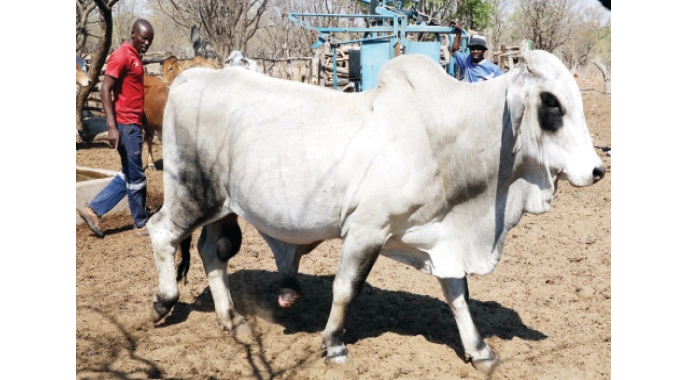Brahman was the first cattle breed to develop in the United States, out of crossbreeding between local European breeds and Bos indicus breeds such as the Guzerat, the Nelore and Gyr, which were imported from India, Mexico and Brazil between 1854 and 1926 to introduce hardier cattle for states such as Louisiana, Texas and California.
Starting off with just four Brahmans comprising three cows and a bull, today Mr Dlamini manages a herd of 66 Brahmans at his plot in Nyamandlovu.
With focus now shifting from livestock rearing for personal consumption to cattle productivity that contributes to the country economic growth in line with Vision 2030 and the National Development Strategy 1 (NDS1), Mr Dlamini’s promising story is just one of many expected to have a significant impact.
Mr Dlamini represents a new crop of smallholder cattle farmers who are taking up livestock breeding seriously and helping the country’s beef industry to slowly get back to its feet.
Through his enterprise, Mr Dlamini has joined other farmers in the country who have taken a bold step towards addressing poor breeding, feeding and health management strategies that had affected cattle production for years.
Notwithstanding the numerous challenges that still bedevil beef cattle production, smallholder farmers are slowly bouncing back and actively contributing towards rebuilding the industry largely affected by illegal sanctions imposed on the country by Western countries.
“I dropped out of school in 1999 when I was doing Form Three following my stepfather’s death. He was the sole breadwinner and that really affected me emotionally and to make matters worse my mother was not working,” he said.
Mr Dlamini said he started moulding bricks and selling them to locals and it was through that business that he managed to raise money and bought a cow, which he later sold and ventured into dog breeding in 2016.
He said in 2018, he decided to diversify and went into Brahman breeding.
“I started with four beasts which cost me US$7 000 and today I have 66 Brahman breeding stock which I bought from a prominent cattle breeder in Esigodini,” he said.
Mr Dlamini sells his quality breeds mostly to farmers in neighbouring Tsholotsho who are keen on improving the quality of their herds. The price of his cattle range between R35 000 and R60 000 depending on the size and weight.
Although, Mr Dlamini is still breeding dogs, his major focus is now on his brahman breeding business.
“Naturally I love breeding animals and that is why I am still keeping dogs. The advantage of breeding Brahmans is that they fetch a good price and have fast growth rate unlike indigenous breeds,” he said.
Mr Dlamini is an active member of the Brahman Breeders Society of Zimbabwe (BBSZ) with a membership of 70 commercial cattle breeders. His cattle are registered in the BBSZ database.
“I am always busy because I have to keep updating my livestock records in our society database. I also do a lot of research so that I acquaint myself with the ever-changing regulations including information on the estimated breeding value for my animals,” he said.
Due to his passion for livestock breeding, Mr Dlamini enrolled for a short course on animal genetics at a farm in Banket.
“I am in the process of looking for a bigger space. I did an artificial insemination course and I am in the process of acquiring the equipment which comprises a flask where nitrogen and semen are kept and guns to inseminate. The purpose of artificial insemination is to introduce a new genetic in the herd,” he said.
Innovative breeding technologies like artificial insemination have been embraced and are bringing in a new breed of cattle.
Artificial insemination increases fertility in cattle through use of scientifically proven technology.
The country is set to generate US$140 million per annum from the successful artificial insemination technology that has the capacity to produce seven million pedigree bull semen straws annually. The project was launched at Chinhoyi University of Technology in 2019.
“The only challenge is inadequate land and right now I am operating in a village where I have neighbours with commercial bulls.
I try my best to make sure they don’t stray into my kraal so that they don’t disturb my breed because I have to raise healthy and quality livestock,” said Mr Dlamini.
He noted that the quality of the herd in most rural communities is still an issue of concern because of poor grazing.
Mr Dlamini, a father of four, is also looking after his four siblings and members of the extended family through his thriving Brahman breeding project.
A majority of smallholder farming households in Zimbabwe are rural based and rely on agriculture to support their livelihoods.
Livestock production in Zimbabwe is an important source of income and a safety net for hundreds of thousands of people, particularly rural women and youth, and is a significant contributor to agricultural GDP.
Last year, President Mnangagwa launched the Livestock Growth Plan, which is part of the Agriculture and Food Systems Transformation Strategy that is expected to turn agriculture into an US$8,2 billion industry by 2025 and contributes towards the achievement of Vision 2030.
According to the Ministry of Lands, Agriculture, Fisheries, Water and Rural Resettlement, livestock is an important source of income for two thirds of rural households and contributes significantly to inclusive growth of the agriculture sector and the economy as well as food and nutrition security.
Plans are underway to earn significant foreign currency for the country through livestock.
hallenges affecting the livestock sector are associated with animal health, sanitary, food safety, genetic improvement and access to infrastructure suitable for accessing lucrative domestic, regional and international markets and inadequate financial resources.
According to the plan, beef production is expected to grow from 50 000 tonnes to 90 000 tonnes per year.
The transformation of the livestock sector through the Livestock Growth Plan is premised on improved animal nutrition and development of pastures. –



